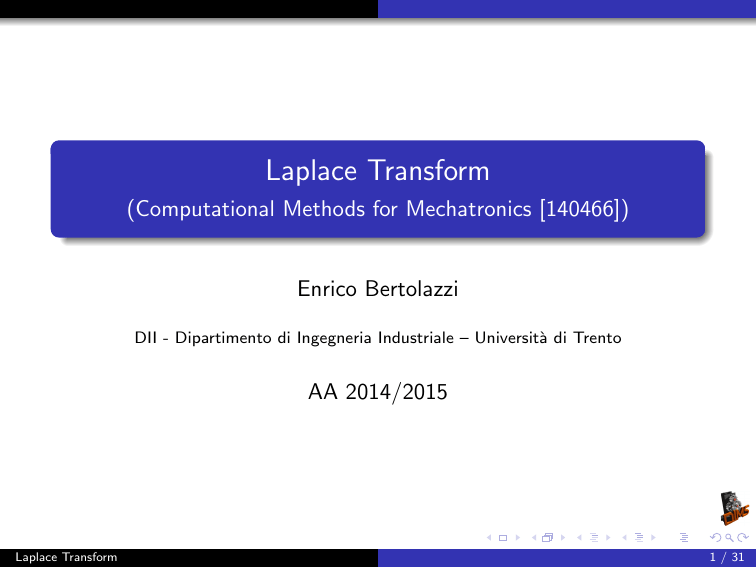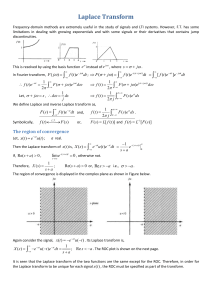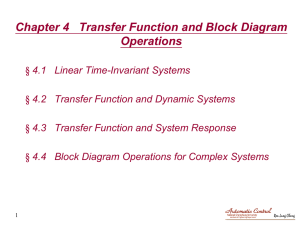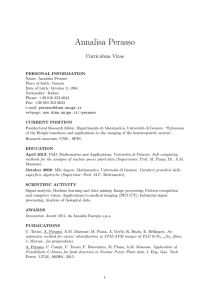Laplace Transform - (Computational Methods for Mechatronics
advertisement

Laplace Transform
(Computational Methods for Mechatronics [140466])
Enrico Bertolazzi
DII - Dipartimento di Ingegneria Industriale – Universit`
a di Trento
AA 2014/2015
Laplace Transform
1 / 31
Outline
1
La trasformata di Laplace
2
Laplace Transform properties
Exponential order functions
3
Some Laplace Transform
Polynomial growth Laplace Transform tk u(t)
Exponential growth Laplace Transform ab t u(t)
Laplace Transform of derivative and integral of a function
4
Altre propriet`a della trasformata di Laplace
Asymptotic values
5
Laplace transform table
6
Laplace Transform, exercise
Laplace Transform
2 / 31
La trasformata di Laplace
Pierre-Simon Laplace, 1749-1827
Laplace Transform
3 / 31
La trasformata di Laplace
Laplace Transform
Definition
f (t) → fb(s) = L {f (t)} (s)
Z +∞
b
f (s) =
f (t)e−st dt = lim
Z
lim
M
→0+ M →+∞ −
0−
f (t)e−st dt
Usefulness: transform
Differential equations
⇒
Algebraic equations
Logarithm analogy:
a → log a
a · b → log a + log b
i.e. logarithm convert products into additions which are easier
to manipulate.
Laplace Transform
4 / 31
La trasformata di Laplace
Laplace Transform as a tool for ODE solution
Differential
equation
Analytical techniques
(constant variations, ...)
Time
response
Laplace Transform
Laplace Trasform
Algebraic
equation
Algebraic techniques
(lienar system, partial fraction expansion,...)
Laplace Inversion
Frequency
response
5 / 31
Laplace Transform properties
Linearity, Translation, Scale change
Laplace Transform properties
Table 1
Linearity
a f (t) + b g(t)
a fb(s) + b gb(s)
1
Scale change
f (at)
1 b s f
a
a
2
Translation respect to s
eat f (t)
fb(s − a)
3
Translation respect to t
f (t − a)
e−as fb(s)
4
a and b are real number. Moreover a > 0 for point 2 and 4.
Laplace Transform
6 / 31
Laplace Transform properties
Linearity and Scale change
L {af (t) + bg(t)} (s) =
Z
+∞
(af (t) + bg(t))e−st dt
0−
Z
+∞
=a
f (t)e
−st
Z
+∞
dt + b
0−
g(t)e−st dt
0−
= a fb(s) + b gb(s)
L {f (at)} (s) =
Z
+∞
f (at)e−st dt
Z
+∞
=
f (z)e−sz/a
0−
=
Laplace Transform
[t = z/a,
a > 0]
0−
dz
a
1 b s f
a
a
7 / 31
Laplace Transform properties
Translation
L e f (t) (s) =
at
Z
+∞
at
−st
e f (t)e
Z
+∞
f (t)e(a−s)t dt
dt =
0−
0−
= fb(s − a)
L {f (t − a)} (s) =
Z
+∞
f (t − a)e−st dz
[t − a = z]
f (z)e−s(z+a) dz
[f (z) = 0 per z ≤ 0]
0−
Z
+∞
=
−a
=e
−sa
Z
+∞
f (z)e−sz dz
0
= e−as fb(s)
Laplace Transform
8 / 31
Laplace Transform properties
Exponential order functions
When Laplace transform exists?
(1/3)
Not all function have a Laplace Transform, for example
Z +∞
n 2o
2
L et (s) =
et −st dt
0−
Z
T
e(t−s)t dt +
=
0−
Z
+∞
e(t−s)t dt
T
for all possible s choose T > Re (s) so that
Z +∞
e(t−s)t dt
T
is not convergent. Thus, the function have not a Laplace
Transform for any s ∈ .
C
Laplace Transform
9 / 31
Laplace Transform properties
Exponential order functions
When Laplace transform exists?
(2/3)
Let be f (t) continuous with bounds: |f (t)| ≤ M eN t for t ≥ T
then the function have a Laplace Transform:
Z T
Z +∞
−st
L {f } (s) =
f (t)e dt +
f (t)e−st dt
0−
In fact,
Z +∞
Z
−st
f (t)e dt ≤
T
T
+∞ f (t)e−st dt ≤
T
Z
Z
+∞
T
+∞
=
Me
N t − Re(s)t
e
Z
e(N − Re(s))t dt
T
+∞
T →+∞ T
Laplace Transform
+∞
dt = M
T
and for Re (s) > N hold
Z
lim
M eN t e−st dt
e(N − Re(s))t dt = 0
10 / 31
Laplace Transform properties
Exponential order functions
When Laplace transform exists?
(3/3)
Definition (Piecewise continuous function)
f (t) is a piecewise continuous function if for all interval [0, T ]
is discontinuous at most on a finite number of points
il finitely bounded
Definition (Exponential order function)
f (t) is an exponential order function if is piecewise continuous with
bound:
|f (t)| ≤ M eN t
per t ≥ T
From now forward we assume the considered functions are of
exponential order with piecewise continuous derivative up to the
required order.
Laplace Transform
11 / 31
Laplace Transform properties
Exponential order functions
Theorem (1)
Let f (t) of exponential order, then:
lim fb(s) = 0,
s→∞
s∈
Proof: Assuming s real
Z ∞
Z
b −st
f (t)e dt ≤
f (s) = 0−
Z
∞
R
|f (t)| e−st dt
0−
∞
≤M
e(N −s)t dt =
0−
M
s−N
but
M
=0
s→+∞ s − N
lim
Laplace Transform
12 / 31
Some Laplace Transform
Polynomial and exponential growth
Polynomial and exponential growth
Heaviside function
(
0
se t < 0;
1
se t ≥ 0.
u(t) =
Linear growth
(
0
se t < 0;
t
se t ≥ 0.
t+ = t u(t) =
Polynomial growth
(
tk+ = tk u(t) =
0
se t < 0;
tk
se t ≥ 0.
Esponenziale growth
(
v(t) = abt u(t) =
Laplace Transform
0
se t < 0;
abt
se t ≥ 0.
13 / 31
Some Laplace Transform
Polynomial and exponential growth
Table 2
1
1
s
5
t
1
s2
6
tk
abt
k!
sk+1
1
s − b log a
7
8
Attention, functions on the first column shall be deemed equal to 0
for t < 0, i.e. f (t) → fb(s) or u(t)f (t) → fb(s) where u(t) is the
Heaviside function.
Laplace Transform
14 / 31
Some Laplace Transform
Heaviside function u(t) Laplace Trasform
Heaviside function
(
0
se t < 0;
1
se t ≥ 0.
u(t) =
Laplace Transform (assuming Re (s) > 0):
Z +∞
Z
−st
L {u} (s) = u
b(s) =
u(t)e dt =
0−
1
= − e−st
s
Laplace Transform
+∞
e−st dt
0−
+∞
=
0−
1
s
15 / 31
Some Laplace Transform
Linear growth Laplace Transform t u(t)
Linear growth
t+ = t u(t)
Laplace Transform (assuming Re (s) > 0):
Z +∞
Z
−st
c
L {t+ } (s) = t+ (s) =
t u(t)e dt =
0−
+∞
te−st dt
0−
Z
t −st +∞ 1 +∞ −st
= − e
+
e dt
s
s 0−
0−
+∞
1
1
= 0+
− e−st
s
s
0−
=
Laplace Transform
1
s2
16 / 31
Polynomial growth Laplace Transform tk u(t)
Some Laplace Transform
Polynomial growth
tk+ = tk u(t)
Laplace Transform (assuming Re (s) > 0):
Z +∞
Z
n o
c
k
k
−st
k
L t+ (s) = t+ (s) =
t u(t)e dt =
0−
= 0+
tk e−st dt
0−
tk
= − e−st
s
+∞
+∞
0−
k
+
s
Z
+∞
tk−1 e−st dt
0−
k d
tk−1 (s)
s +
1
Using induction and noticing that tc
+ (s) = 2 it follows
s
k (s) = k!
tc
+
sk+1
Laplace Transform
17 / 31
Exponential growth Laplace Transform ab t u(t)
Some Laplace Transform
Exponential growth
v(t) = abt u(t)
Laplace Transform (assuming Re (s) > b log a):
Z +∞
Z +∞
n o
bt
bt
−st
L a (s) =
a u(t)e dt =
abt e−st dt
0−
Z
+∞
=
0−
ebt log a e−st dt =
0−
=
=
Laplace Transform
Z
+∞
e(b log a−s)t dt
0−
1
e(b log a−s)t
(b log a − s)
+∞
0−
1
s − b log a
18 / 31
Some Laplace Transform
Laplace Transform of derivative and integral of a function
First derivative Laplace Transform
(1/2)
Theorem (First derivative Laplace Transform)
Let f (t) of exponential order with piecewise continuous first
derivative. The Laplace Transform of f 0 (t) becomes:
L f 0 (t) (s) = sfb(s) − f (0+ )
(assuming f (t) = 0 for t ≤ 0)
Proof: Let Re (s) > 0 and β > 0:
Z +∞
Z
+∞
f 0 (t)e−st dt = f (t)e−st β + s
β
+∞
f (t)e−st dt
β
= −f (β)e−sβ + s
Z
+∞
f (t)e−st dt
β
Laplace Transform
19 / 31
Some Laplace Transform
Laplace Transform of derivative and integral of a function
First derivative Laplace Transform
and thus,
Z
Z +∞
0
−st
f (t)e dt = lim
β→0
−
0
0
−st
f (t)e
(2/2)
Z
dt +
−
0
f (t)e
−st
dt
β
+∞
Z
= lim −f (β)e−sβ + s
β→0
= −f (0+ ) + s
+∞
f (t)e−st dt + 0
β
Z
+∞
f (t)e−st dt
0+
from f (t) = 0 for t ≤ 0 it follows
0
R0
−st dt
− f (t)e
L f (t) (s) = −f (0+ ) + s
Laplace Transform
Z
+∞
= 0 and
f (t)e−st dt.
0−
20 / 31
Some Laplace Transform
Laplace Transform of derivative and integral of a function
k-th derivative Laplace Transform
Theorem (k-th derivative Laplace Transform)
Let f (t) of exponential order up to k − 1-derivative and k-th
derivative piecewise continuous. Then Laplace Transform of k-th
derivative become:
k−1
n
o
X
(k)
kb
si f (k−i−1) (0+ ).
L f (t) (s) = s f (s) −
i=0
(assuming f (t) = 0 for t ≤ 0)
Proof: Is similar to the proof for first derivative using k-times
integration by part.
Laplace Transform
21 / 31
Some Laplace Transform
Laplace Transform of derivative and integral of a function
Laplace Transform of an integral
Theorem (Laplace Transform of an integral)
Let f (t) piecewise continuous and g(t) defined as
Z t
g(t) =
f (z) dz
0
Laplace transform L {g(t)} (s) = gb(s) become:
1
gb(s) = fb(s).
s
Proof: Apply derivation rule for the function g(t) and observe that
g 0 (t) = f (t) and g(0) = 0.
Laplace Transform
22 / 31
Altre propriet`
a della trasformata di Laplace
Asymptotic values
Initial and final value
Theorem (of the initial value)
Let f (t) of exponential order with piecewise continuous first
derivative, then:
f (0+ ) = lim sfb(s)
s→+∞
s∈
R
Proof: From theorem 1 with f 0 (t)
0 = lim L f 0 (t) (s) = lim sfb(s) − f (0+ )
s→+∞
Laplace Transform
s→+∞
23 / 31
Altre propriet`
a della trasformata di Laplace
Asymptotic values
Theorem (of the final value)
Let f (t) of exponential order with piecewise continuous first
derivative, if the limit f (+∞) = limt→+∞ f (t) exists then:
f (+∞) = lim sfb(s)
s→0
s∈
R
Z
∞
Proof: Using Laplace Transform of f 0 (t)
lim L {f 0 (t)} (s) = lim+ sfb(s) − f (0+ )
s→0+
s→0
lim L {f 0 (t)} (s) = lim
s→0+
Z
s→0+
Z
∞
0−
f 0 (t)e−st dt =
f 0 (t) lim e−st dt
0−
s→0+
∞
=
f 0 (t) dt = f (+∞) − f (0+ )
0−
Here we use Lebesgue’s dominated convergence theorem.
Laplace Transform
24 / 31
Altre propriet`
a della trasformata di Laplace
Moltiply by tn
L {tn f (t)} (s) = (−1)n
dn b
f (s)
dsn
Division by t. Let g(t) = tf (t) then from the previous formula
d
L {f (t)} (s)
ds
n o
d
that can be written as: ds
L g(t)
(s) = −b
g (s) or better
t
L {g(t)} (s) = −
L
g(t)
t
Z
(s) = −
gb(s) ds + C = b
h(s)
Complex constant C must be chosen such that b
h(s) satisfy
initial and final value theorem. Obviously limt→0+ g(t)/t must
exists and must be finite.
Laplace Transform
25 / 31
Altre propriet`
a della trasformata di Laplace
Periodic function and convolution
Theorem (Periodic function Laplace Transform)
Let f (t + T ) = f (t) for t > 0 then
RT
L {f (t)} (s) =
0
f (t)e−st dt
1 − e−sT
Theorem (Laplace Transform of a convolution)
Let (f ? g)(t) defined as:
Z
t
f (z)g(t − z) dz
(f ? g)(t) =
0
then
L {f ? g} (s) = fb(s) gb(s)
Laplace Transform
26 / 31
Laplace transform table
Integral and derivative transform
Table 3
t
Z
1b
f (s)
s
9
f 0 (t)
sfb(s) − f (0+ )
10
f 00 (t)
s2 fb(s) − f 0 (0+ ) − sf (0+ )
11
f (z) dz
0
dn
f (t)
dtn
tn f (t)
(f ? g)(t)
Laplace Transform
n
s fb(s) −
n−1
X
sn−j−1 f (j) (0+ )
12
dn b
f (s)
dsn
13
j=0
(−1)n
fb(s) gb(s)
14
27 / 31
Laplace transform table
Laplace Transform of some elementary functions
Table 4
Laplace Transform
eat cos ωt
s−a
(s − a)2 + ω 2
15
eat sin ωt
ω
(s − a)2 + ω 2
16
eat cosh ωt
s−a
(s − a)2 − ω 2
17
eat sinh ωt
ω
(s − a)2 − ω 2
18
eat tn
n!
(s − a)n+1
19
eαt − eβt
α−β
(s − α)(s − β)
20
28 / 31
Laplace Transform, exercise
Periodic function Laplace Transform
0
n
(0
g(t) = +1
−1
(0
h(t) = t − 2n
2n + 2 − t
t<0
n≤t<n+1
t<0
2n ≤ t < 2n + 1
2n + 1 ≤ t < 2n + 2
t<0
2n ≤ t < 2n + 1
2n + 1 ≤ t < 2n + 2
f (t) =
1
2
3
4
1,0
0,9
0,8
3
0,5
0,7
0,6
2
0,5
0
1
2
3
4
0,4
t
0,3
1
K
0,2
0,5
0,1
0
0
1
2
3
4
t
1
fb(s) = s
;
(e − 1) s
Laplace Transform
0
K
0
1,0
es
1 −1
gb(s) =
;
s es + 1
1
2
3
4
5
6
t
1 es − 1
b
h(s) = 2 s
s e +1
29 / 31
Laplace Transform, exercise
1
2
3
Periodic function Laplace Transform
f (t) = |sin(t)|
sin(t)
g(t) =
t
h(t) = sin(t)3
1,0
1,0
1,0
0,8
0,8
0,5
0,6
0,6
0,4
0
1
0,4
2
3
4
5
6
7
8
9
t
0,2
K
0,2
0,5
0
1
0
1
2
3
4
5
6
7
t
fb(s) =
Laplace Transform
2
3
4
5
6
7
8
9
t
0
8
9
K
0,2
K
1,0
1 eπs + 1
;
gb(s) = arctan(s);
1 + s2 eπs − 1
6
b
h(s) = 2
(s + 1)(s2 + 9)
30 / 31
Riferimenti
References
Joel L. Schiff
The Laplace Transform, theory and applications
Springer-Verlag, 1999.
U. Graf
Applied Laplace Transforms and z-Transforms for Scientists
and Engineers
Birkh¨auser, 2004.
Spiegel Murray R.
Laplace transforms
Schaum’s outline series, 1965.
Laplace Transform
31 / 31


